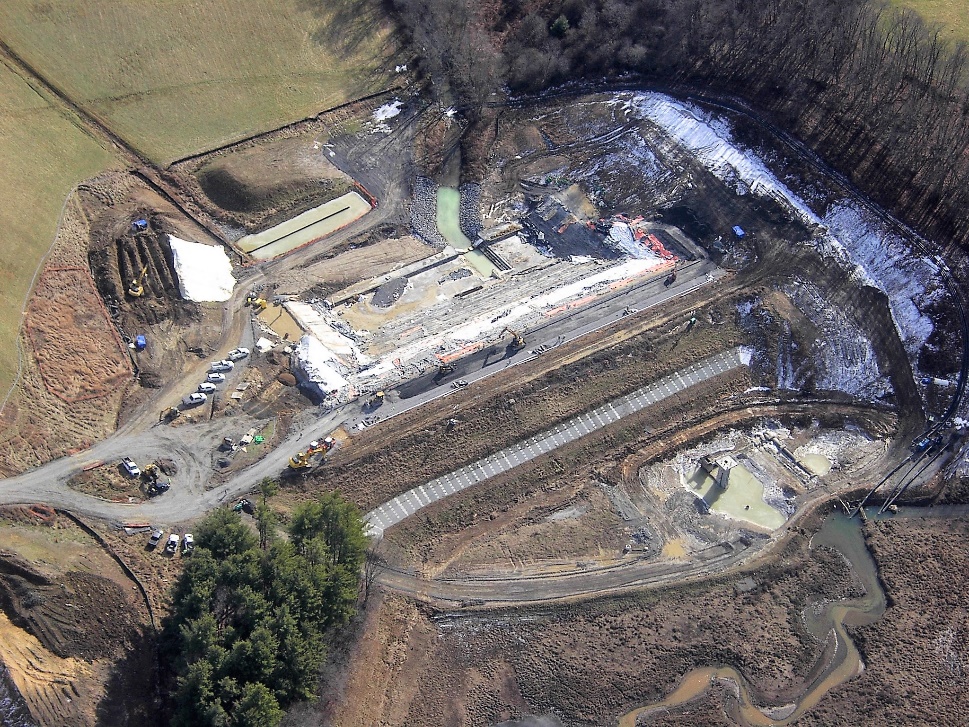REEDSVILLE — Preston County Public Service District 1 submitted to The Dominion Post these answers to many of the questions most commonly asked by its customers, regarding the dam project.
Who determined the dam needed to be rehabilitated?
The USDA Natural Resources Conservation Service (NRCS) determined that during the 2006 dam assessment, so the dam could be brought into compliance with current West Virginia Department of Environmental Protection (WVDEP) Dam Safety and NRCS design and safety criteria due to downstream development. As part of the dam rehabilitation project a dedicated water supply was included for the community.
Who is in charge of the construction contract?
The Monongahela Conservation District is the contracting organization for the project, administering contract in conjunction with input and oversight from WVCA and NRCS.
When is the project expected to be completed and when can the reservoir be filled?
About two months of weather-dependent work remain. The construction contractor is making accommodations to complete earthwork during less than favorable
conditions.
The NRCS and WVDEP Dam Safety will conduct a final inspection of the dam upon completion, estimated to be this spring. Upon final approval, the control gate can be closed, and water will begin to be stored. Depending on the amount of rainfall, the water within the reservoir could be used by Public Service District No. 1 (PSD 1) after one month of filling.
Why did the project take so long?
There were multiple factors responsible for the delays: unforeseen sub-surface conditions at the Impoundment No. 1 site and unusual wet conditions spring through fall of 2018.
Moving forward, the contractor is completing concrete pours and earthwork as the weather allows. The contractor is mobilizing necessary equipment to warm the concrete and dry the soils.
Project sponsors have coordinated with WVDEP Dam Safety to streamline the post construction procedures required to close the control gate. The local sponsors include the State Conservation Committee, Monongahela Conservation District and Public Service District 1.
How much water will the new dam hold?
The new 36-acre lake will contain over 100 million gallons of raw water supply. The old 23-acre lake contained 21 million gallons and did not contain a dedicated raw water supply. Although the PSD withdrew water from the 23-acre lake, it was originally designed for flood control purposes only.
Who is paying for the project?
USDA NRCS, State Conservation Committee and the PSD. The PSD is paying for the portions of the project strictly related to the water supply features and the mitigation costs associated with the impact to wetlands and streams caused by the raise in reservoir water level.
How much will it cost to maintain the dam? Is the PSD responsible for ongoing maintenance?
The project sponsors are responsible for operating and maintaining the dam and appurtenances. The PSD, along with other sponsors, shares a role in maintaining the dam. The West Virginia Conservation Agency also conducts monthly inspections, while NRCS participates in annual dam inspections.
Who will own the dam?
The State Conservation Committee and WVU own the property adjacent to the lake. The PSD will have rights to the dedicated raw water supply.
Why would the PSD want to own/have the rights to the water?
The PSD must comply with state law (West Virginia Senate Bill 373), which requires two raw water supply sources. The dedicated water supply provided with the dam rehabilitation will provide six months of water during a drought.
Why does my water bill keep increasing?
The West Virginia Public Service Commission approved a rate increase when the project was started to assist in the payment of projected costs associated with the PSD’s involvement. A second rate increase was approved after the actual project costs were identified.
Is it really safe to drink my water even though it is discolored or has an odor?
The West Virginia State Health Department tests the water for quality. The water, although aesthetically displeasing at times, does meet all guidelines for safe use. The PSD will notify all customers if the water is not approved for safe drinking, cooking or sanitary use.
What can I do if the water coming out of my faucets is discolored or has an odor?
First, flush the water lines in your home by allowing cold water to run for three-four minutes. You should turn on the water to each faucet individually and allow to run for approximately 30-45 seconds per water faucet. This should remove any residual effects from the water lines in the home. If the water does not return to clear, notify the PSD office at 304-864-3014.
How much longer will my water be affected?
The PSD will continue to use water from Upper Decker’s Creek Site 6 Dam for the duration of this project. Once the project is completed and the new water reservoir is filled, the district will begin to use water from Upper Deckers Creek Site 1 Dam. Upper Deckers Creek Site 1 Dam will become the PSD’s new, permanent water source.
Will we be allowed to use the dam for recreation?
It has not been designated for recreational use.
Were any wetlands or wildlife habitat damaged during the rehabilitation?
The construction did not permanently impact wetlands or wildlife habitat. However, it did impact a short distance of stream downstream of the dam.
The increased water surface elevation to include raw water supply will permanently impact wetlands and streams leading to the reservoir. These impacts will be re-established along the new shoreline and nearby areas through a combination of preservation, restoration and purchases from approved mitigation banks.




